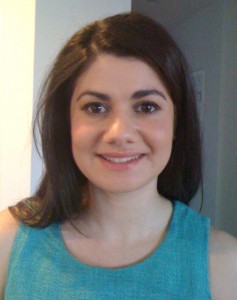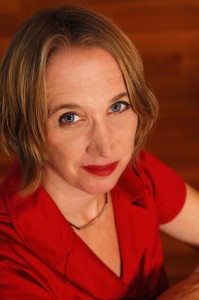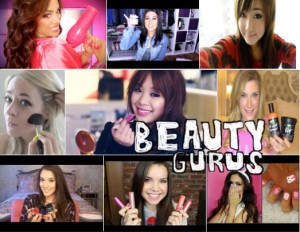 Victoria Baritz (pictured here), a non-profit professional and political activist in New York whose work has focused on educational access and women’s empowerment, emailed me recently with questions about my career path, and the feminist nonprofits I’ve worked with along the way. I thought I’d post my responses to her questions as this month’s column, in the hope that sharing my story might be helpful to others following “alt-ac” (as in alt academic) and or/feminist paths. And speaking of following, you can follow Victoria on Twitter @victoriabaritz. She’ll be one to watch.
Victoria Baritz (pictured here), a non-profit professional and political activist in New York whose work has focused on educational access and women’s empowerment, emailed me recently with questions about my career path, and the feminist nonprofits I’ve worked with along the way. I thought I’d post my responses to her questions as this month’s column, in the hope that sharing my story might be helpful to others following “alt-ac” (as in alt academic) and or/feminist paths. And speaking of following, you can follow Victoria on Twitter @victoriabaritz. She’ll be one to watch.
VB: What skills have been most helpful in building your career?
DS: My journey has been a bit atypical. Unlike many writers I know, I’m extremely social. An extrovert. Networking is something I’ve always done, without necessarily calling it that. I find people and their stories fascinating. I think that curiosity has served me.
Also, I have a hunger to learn new tricks. Eight years in graduate school left me with the ability to get smart fast on topics that seem foreign or overwhelming. That quality deepened over time. When I left academe, I got excited about embracing new technologies. These days, I’m all about embracing new modes for disseminating ideas—TEDx, Pinterest, Cowbird, Tumblr, more.
VB: Could you tell me a little bit about how you developed your career?
DS: Before getting into the nitty gritty, here’s what I’m up to these days. After 20 years translating specialized knowledge for popular consumption, I’m now working one-on-one as a thought leadership coach and consultant while working toward my next book. I recently lead a webinar hosted by She Writes, called Thought Leadership for Writers, which shows my approach to it all. (A sampler is below.)
I’m sharing what I know as an author and platform creator by teaming up with emerging and established thought leaders wishing to differentiate or amplify their written voice, migrate “think-filled” activities to the web, and connect passionately through words—on the page, on the TEDx stage, and online. (New logo, below!)
I’ve been a consultant for over 15 years, but my primary focus on coaching individuals is more recent. On other fronts, I’m currently a Visiting Scholar in Gender and Sexuality Studies at Northwestern University and Director of the OpEd Project’s Public Voices Fellowship Program for faculty at DePaul University, now in its second year. I’ve been an author and professional speaker from 2007 on, when my first two books appeared. I’m one of those people my friend Marci Alboher describes as having a “slash career,” meaning one that integrates multiple passions, like author/speaker/consultant. I’m a multi-tasker, for sure, but one of the most important lessons I’ve learned over time is that multi-purposing is far more effective (not to mention sanity-inducing) than multi-tasking.
My current vocation is all about multi-purposing, in other words, repurposing knowledge, content, and skills. I’m helping others forge the bridge to a public voice, even as I continue to learn new skills to further my own. I’m multi-purposing life’s content in that my next book is about my boy/girl twins, or rather, it’s a graphic memoir about the gendering of childhood in the earliest years. I sense multi-purposing might be a helpful quality to develop early on, if you plan on living with slashes. Make sure your various roles feed each other. Otherwise, you burn out. There are only so many hours in a day.
So that’s where I’ve ended up. How’d I get where I am now? It’s a longer story, and not a linear one, so I’ll share the bulleted version. It sounds something like this:
- After college, still hungered for knowledge. Needed to immerse in world of professional work first. Interned and then worked at the Center for the Education of Women in Ann Arbor, where attended college. Was generously mentored (thank you, Carol Hollenshead), and landed a life-changing job at the National Council for Research on Women, an umbrella organization of women’s research and policy centers based in New York City.
- Hired by Council short-term to draft a report on sexual harassment, on the eve of Anita Hill’s charges against then-Supreme Court nominee Clarence Thomas. Ended up staying two years. Generously mentored once again (thank you, Mary Ellen Capek, Debra Schultz, and the late Mariam Chamberlain, otherwise known as fairy godmother to Women’s Studies). Side note: While interviewing at Council, was simultaneously looking for editorial job at women’s magazine. Ms. seemed like Mecca, but was also interviewing at glossies, where would have ended up penning sex tips instead of synthesizing research on sexual harassment. Life funny that way.
- Inspired by Council colleagues, thought might like to be nonprofit leader one day. Higher ups at Council and member organizations had PhD’s. Decision to pursue doctorate confirmed.
- In graduate school, remained passionate about writing for broader audience than academic. But struggled. A lot. Sought out opportunities to gain skills, in addition to teaching, that might transfer to realms outside academe. Apprenticed with and generously mentored by editor of American Literary History. Interned at university press. Gained professional editorial skills. Generously mentored by feminist academics (thank you Susan Stanford Friedman, Susan Bernstein, the late Nellie McKay), who ultimately supported me in pursuing an alt academic path.
- New York City beckoned. Again. Took leave of absence, moved, worked as Content Strategist (dot com language circa late 1990s for someone with editorial skills) for various tech start-ups in Silicon Alley. Joined Webgrrls. Learned basic html (pre-Wordpress). Pseudonymously launched “Dottie and Jane’s Adventures Beyond the Ivory Tower” with friend.
- Finished dissertation. Became Visiting Fellow at Barnard Center for Research on Women, where helped launch webjournal, The Scholar & Feminist Online. Became Visiting Scholar at Center for Education of Women. Reinvented as feminist journalist. Rewrote dissertation into more commercial book, after apprenticing self to friend, Katie Orenstein, who helped whip prose into shape. Joined WAM! (Women, Action, Media), then just starting. Invited to be part of first class of Women’s Media Center Progressive Women’s Voices training program. Sharpened media skills.
- Returned to Council, working closely with member centers (think tanks, policy centers, advocacy orgs) and on communications and reports that drew on network at large. Generously mentored by Linda Basch.
- Left Council the year first book pubbed. Launched Girl w/Pen blog. Began career as author/speaker/consultant, working with thinkers in nonprofit and business sectors and helping think tanks, advocacy and policy organizations deepen public impact through written word. Developed first workshop, “Making It Pop: Translating Your Ideas for Trade.”
- Tech and entrepreneurship beckoned. Again. Joined visionary Kamy Wicoff to create a social network for women writers, She Writes (now 23,000+ members strong).
- Katie Orenstein beckoned. Joined The OpEd Project, helped bring programs to the Midwest.
- Left New York City for Chicago in 2012, when toddler twins hit preschool.
Again, my journey hasn’t been linear. I’ve ricocheted between New York City and the Midwest, multiple times. I’ve reinvented, then reinvented again. I’ve tried to live by that Eleanor Roosevelt quote that’s on the back of my current business card: “You must do the thing you think you cannot do.”
The other quote I live by: E.B. White wrote in Here Is New York that a requirement for success in that city is the willingness to be lucky. I like this statement because it combines serendipity and will. You have to believe in yourself to the extent that you feel entitled to make your own luck. I credit my parents for that.
There’s a fair degree of luck, I think, in finding good mentors. But a willingness to be mentored is a quality I encourage for those just starting out. And mentoring works best when it’s a two-way street. Many of those I’ve mentored have since ended up mentoring me back. (Thank you, Courtney Martin.)
VB: What organizations that work with women’s causes in New York do you admire?
DS: So many. I adore the Women’s Media Center. Their Progressive Women’s Voices training is top notch. The National Council for Research on Women will always be close to my heart, and I’ve long held an affinity for The Feminist Press. Catalyst is outstanding; their research grounds so much of contemporary debate about glass ceilings in business, and work/life. Girls, Inc and Girls Write Now are two of my favorite organizations servicing girls. And The OpEd Project, of course, is a social venture of which I’m honored to be a part.
Here in Chicago I’ve become an admirer of Women Employed, Chicago Foundation for Women, the Jewish Women’s Foundation of Metropolitan Chicago. And I’m still learning about new organizations out here all the time.
VB: What are some of the challenges involved in working at a feminist organization?
DS: So many feminist nonprofits are financially challenged; they’re doing the best they can with scarce resources. It constantly amazes me how much even the most challenged organizations can push out. But when an organization is fighting to stay alive, the atmosphere can be that of a pressure cooker. Also, there’s often the expectation, going in, of a nonhierarchical structure, which, for practical purposes, is frequently not the case. Generational tensions arise, as they do anywhere, but at feminist organizations these tensions can be intense, in part because of the outsized expectations we have going in.
I generally advise people interested in feminist organizational work to enter it with eyes open, just as they would any other line of work. I think it’s important to talk to people currently working at the places you’re interested in, to learn about the culture and the financial health of the organization overall, because these factors set the tone.
VB: Are there any professional or volunteer organizations that you would recommend joining?
DS: I’ve benefited hugely from networking organizations where a main focus is women helping women. Some of those I belonged to in the past no longer exist, but newer ones on my radar right now include Step Up Women’s Network (with branches in New York, Chicago, and LA). Also, it’s important to join professional organizations in your field – WAM! and Journalism and Women Symposium (JAWS), if you’re a woman journo; Women in Communications, if that’s your deal; Webgrrls if you’re a woman interested in learning more tech; and so forth. Personally, I’m finding the Women’s Business Development Center to be an enormous help, at this stage in my path.
VB: What publications do you read to stay informed?
DS: It changes. These days, aspirationally at least, the list includes The New York Times, Talking Points Memo, Bitch, feministing, Racialicious, RH Reality Check, The Hairpin, Jezebel, The Juggle (WSJ blog), ForbesWoman, Women’s eNews, Women and Hollywood, Truthout, DoubleX, Salon, Buzzfeed, Upworthy, Brain Child.
And the Council on Contemporary Families briefing that goes out to members is something I can’t live without. (To those interested, you can join CCF, here.)
VB: What are some of the developments that you see in women’s activism?
DS: There’s way too much going on to do justice to here, so I’m going to answer this one in list form, a-z, with links. The organizations and initiatives below represent some of the developments I’m most excited about, with the caveat that this list is partial, and that I’m, of course, partial to causes in which I’m currently engaged.
Follow Deborah on Twitter @deborahgirlwpen


